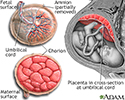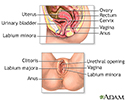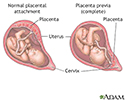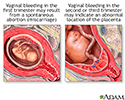Multimedia Gallery






Pneumothorax - series
Pneumothorax - series - normal anatomy
The lungs are paired organs that lie in the thoracic cavity. The lungs extract oxygen from inhaled air and transport the oxygen to the blood. Surrounding the lungs is a very thin space called the pleural space. The pleural space is usually extremely thin, and filled with a small amount of fluid.
Pneumothorax - series
Pneumothorax - series - normal anatomy
The lungs are paired organs that lie in the thoracic cavity. The lungs extract oxygen from inhaled air and transport the oxygen to the blood. Surroun...
Pneumothorax - series
Indications, part 1
If air enters the pleural space, the lung will collapse. This is called a pneumothorax. If the chest wall is penetrated, which may occur as a result of an injury, air can enter the pleural space from the outside. Air can also enter from the inside, from the lung itself, if the lung is torn or ruptured. One of the most common causes of spontaneous non-traumatic pneumothorax is a pulmonary bleb. This is a weakness and out-pouching of the lung tissue, which can rupture. This introduces air into the pleural space.
Pneumothorax - series
Indications, part 1
If air enters the pleural space, the lung will collapse. This is called a pneumothorax. If the chest wall is penetrated, which may occur as a result ...
Pneumothorax - series
Incision
Pneumothorax can be life-threatening. The immediate treatment for pneumothorax is tube thoracostomy, or the insertion of a chest tube. A long, flexible, hollow, narrow tube is inserted through the ribs into the pleural splace, and the tube is attached to a suction device. This allows the air to be evacuated from the pleural space, and allows the lung to re-expand. Chest tubes are generally inserted using local anesthesia. The chest tube is left in place until the lung leak seals on its own; this usually occurs within two to five days.
Pneumothorax - series
Incision
Pneumothorax can be life-threatening. The immediate treatment for pneumothorax is tube thoracostomy, or the insertion of a chest tube. A long, flexib...
Pneumothorax - series
Indications, part 2
Pulmonary blebs are a common cause of spontaneous pneumothorax in young children and adults. Blebs are weakened out-pouchings in the upper lung, which can rupture, causing pneumothorax.
Pneumothorax - series
Indications, part 2
Pulmonary blebs are a common cause of spontaneous pneumothorax in young children and adults. Blebs are weakened out-pouchings in the upper lung, whic...
Pneumothorax - series
Procedure
Pulmonary blebs can be resected, preventing future pneumothorax. This is frequently done using a thoracoscopic surgical procedure. The patient is put to sleep using general anesthesia. Long, narrow instruments, including one with a camera on the end to allow for visualization of the interior of the thorax, are introduced through small incisions in the chest wall.
Pneumothorax - series
Procedure
Pulmonary blebs can be resected, preventing future pneumothorax. This is frequently done using a thoracoscopic surgical procedure. The patient is put...
Pneumothorax - series
Aftercare
A stapling device is inserted into the chest during thoracoscopic surgery, and the segment of lung with blebs is stapled across and then removed. Most patients respond quite well to this procedure, and usually require one to three days in the hospital after surgery to recover. A chest tube is frequently left in place for one to two days after surgery to evacuate any residual air in the pleural space.
Pneumothorax - series
Aftercare
A stapling device is inserted into the chest during thoracoscopic surgery, and the segment of lung with blebs is stapled across and then removed. Mos...
Review Date: 1/8/2025
Reviewed By: Jesse Borke, MD, CPE, FAAEM, FACEP, Attending Physician at Kaiser Permanente, Orange County, CA. Also reviewed by David C. Dugdale, MD, Medical Director, Brenda Conaway, Editorial Director, and the A.D.A.M. Editorial team.
The lungs are paired organs that lie in the thoracic cavity. The lungs extract oxygen from inhaled air and transport the oxygen to the blood. Surrounding the lungs is a very thin space called the pleural space. The pleural space is usually extremely thin, and filled with a small amount of fluid.
If air enters the pleural space, the lung will collapse. This is called a pneumothorax. If the chest wall is penetrated, which may occur as a result of an injury, air can enter the pleural space from the outside. Air can also enter from the inside, from the lung itself, if the lung is torn or ruptured. One of the most common causes of spontaneous non-traumatic pneumothorax is a pulmonary bleb. This is a weakness and out-pouching of the lung tissue, which can rupture. This introduces air into the pleural space.
Pneumothorax can be life-threatening. The immediate treatment for pneumothorax is tube thoracostomy, or the insertion of a chest tube. A long, flexible, hollow, narrow tube is inserted through the ribs into the pleural splace, and the tube is attached to a suction device. This allows the air to be evacuated from the pleural space, and allows the lung to re-expand. Chest tubes are generally inserted using local anesthesia. The chest tube is left in place until the lung leak seals on its own; this usually occurs within two to five days.
Pulmonary blebs are a common cause of spontaneous pneumothorax in young children and adults. Blebs are weakened out-pouchings in the upper lung, which can rupture, causing pneumothorax.
Pulmonary blebs can be resected, preventing future pneumothorax. This is frequently done using a thoracoscopic surgical procedure. The patient is put to sleep using general anesthesia. Long, narrow instruments, including one with a camera on the end to allow for visualization of the interior of the thorax, are introduced through small incisions in the chest wall.
A stapling device is inserted into the chest during thoracoscopic surgery, and the segment of lung with blebs is stapled across and then removed. Most patients respond quite well to this procedure, and usually require one to three days in the hospital after surgery to recover. A chest tube is frequently left in place for one to two days after surgery to evacuate any residual air in the pleural space.






Animations
- Abdominal aortic aneurysm
- Abdominal pain
- ACL injury
- Acne
- Alcoholic liver disease
- Allergic rhinitis
- Allergies
- Allergy testing
- Allergy to mold - animal da...
- Alzheimer disease
- Alzheimer disease
- Anemia
- Ankylosing spondylitis
- Anterior shoulder stretch
- Anti-reflux surgery
- Appendectomy
- Appendicitis
- Arm reach
- Arthritis
- Asthma
- Atherosclerosis
- Atopic dermatitis
- Atrial fibrillation
- Basal cell carcinoma
- Bipolar disorder
- Bladder function - neurolog...
- Breast cancer
- Breast engorgement
- Breast lift
- Breast self-exam
- Breastfeeding
- Bronchitis
- Bronchoscopy
- Bunion
- Cardiac catheterization
- Carpal tunnel syndrome
- Cataract
- Cataracts
- Cell division
- Cervical cancer
- Cesarean section
- Chest pain
- Cholesterol and triglycerid...
- Chronic obstructive pulmona...
- Cluster headache
- Colon cancer
- Colorectal polyps
- Common cold
- Conception - general
- Conception - pregnancy
- Conception of identical twins
- Concussion
- Cosmetic surgery of the face
- Crohn disease
- C-section
- Depression
- Diabetes
- Dialysis
- Diarrhea
- Early labor
- Egg cell production
- Egg production
- Electrocardiogram
- Endometriosis
- Epilepsy
- Essential hypertension
- External rotation with band
- Fibromyalgia
- Flu
- Food poisoning
- Foot pain
- Formation of twins
- Gallstones
- Gastroesophageal reflux disease
- Getting rid of lice in the home
- Glaucoma
- Hardening of arteries
- HbA1c
- Head injury
- Healthy Guide to Fast Food
- Hearing loss
- Heart attack
- Heart failure
- Heartburn
- Heel pain
- Hepatitis A
- Hepatitis B
- Hepatitis C
- Hernia
- Herniated disk
- Hip joint replacement
- Hodgkin lymphoma
- How to remove a splinter
- How to treat a nosebleed
- How to treat a sunburn
- How to use a peak flow meter
- How to use a pill cutter
- How to use eye drops
- How to use nasal sprays
- Hypertension
- Hyperthyroidism
- Hypothyroidism
- Hysterectomy
- Insomnia
- Internal rotation with band
- Iron deficiency anemia
- Irritable bowel syndrome
- Isometric
- Kidney stones
- Kidney stones
- Knee joint replacement
- Let's talk about pink eye
- Liposuction
- Lung cancer
- Lyme disease
- Lymphatics and the breast
- Melanoma
- Menopause
- Migraine
- Multiple sclerosis
- Nasal congestion
- Neck pain
- Nuclear stress test
- Obstructive sleep apnea
- Osteoarthritis
- Osteoarthritis
- Osteoporosis
- Osteoporosis
- Ovulation
- Pap smear
- Pendulum exercise
- Peptic ulcer
- Pharyngitis
- Placenta delivery
- Placenta formation
- Plantar fasciitis
- Pneumonia
- Preeclampsia
- Pregnancy
- Pregnancy care
- Psoriasis
- Rheumatoid arthritis
- Rotator cuff problems
- Rupturing membranes
- Sciatica
- Seizures
- Shingles
- Shoulder blade retraction
- Shoulder blade retraction w...
- Shoulder pain
- Sinusitis
- Sleep disorders
- Smoking tips to quit
- Snoring
- Spinal stenosis
- Stent
- Storing breast milk
- Strep throat
- Stretching back of your shoulder
- Stroke
- Systemic lupus erythematosus
- Tension headache
- The difference between a co...
- The role of amniotic fluid
- Tips on buying cold and flu...
- Tips on removing ear wax
- Tracking your blood pressur...
- Treating eyelid bumps
- Twin-to-twin transfusion sy...
- Type 2 diabetes
- Ulcerative colitis
- Ultrasound
- Understanding cholesterol r...
- Up the back stretch
- Urinary incontinence
- Urinary tract infection - adults
- Uterine fibroids
- Vacation health care
- Vaginal delivery
- Varicose veins
- Venous insufficiency
- Wall push-up
- Wall stretch
- Warts
- What are hives?
- What causes wheezing?
- What in the world is a neti pot?
- What is tennis elbow?
- What makes your heart beat?
- What to do when something g...
Illustrations
- 3D ultrasound
- Abnormal discharge from the...
- Abnormal menstrual periods
- Absence of menstruation (am...
- Amniocentesis
- Amniotic fluid
- Anatomy of a normal placenta
- Anterior vaginal wall repair
- Bleeding between periods
- Breast infection
- Breast lumps
- Breast pain
- Breast self-exam
- Breast self-exam
- Breast self-exam
- Breastfeeding
- Causes of breast lumps
- Causes of breast lumps
- Causes of painful intercourse
- Causes of sexual dysfunction
- Causes of vaginal itching
- Cervical biopsy
- Cervical cancer
- Cervical cancer
- Cervical cryosurgery
- Cervical cryosurgery
- Cervical erosion
- Cervical neoplasia
- Cervical polyps
- Cervicitis
- Cervix needle sample
- Cesarean section
- Cesarean section
- Cesarean section
- Childbirth
- Cold cone removal
- Colposcopy-directed biopsy
- Culdocentesis
- D and C
- Delivery presentations
- Depression and the menstrua...
- Developmental disorders of ...
- Early pregnancy
- Early weeks of pregnancy
- Ectopic pregnancy
- Emergency Childbirth
- Emergency Childbirth
- Endometrial biopsy
- Endometrial biopsy
- Endometrial cancer
- Endometriosis
- Endometritis
- Episiotomy aftercare
- Excision of breast lump
- Female breast
- Female perineal anatomy
- Female reproductive anatomy
- Female reproductive anatomy
- Female reproductive anatomy...
- Female urinary tract
- Female-pattern baldness
- Fibrocystic breast change
- Fibroid tumors
- First trimester of pregnancy
- Folic acid
- Genetic counseling and pren...
- Gestational ages
- Gestational diabetes
- Hysterectomy
- Inflatable artificial sphincter
- Intraductal papilloma
- Lumpectomy
- Mammary gland
- Mammography
- Mammoplasty
- Menopause
- Morning sickness
- Nabothian cyst
- Necrobiosis lipoidica diabe...
- Necrobiosis lipoidica diabe...
- Needle biopsy of the breast
- Normal female anatomy
- Normal female breast anatomy
- Normal uterine anatomy (cut...
- Open biopsy of the breast
- Oral glucose tolerance test
- Ovarian cancer
- Ovarian cancer dangers
- Ovarian cancer metastasis
- Ovarian cyst
- Ovarian cysts
- Ovarian growth worries
- Pap smear
- Pap smear
- Pap smears and cervical cancer
- Pelvic adhesions
- Pelvic laparoscopy
- Peritoneal and ovarian canc...
- Placenta
- Placenta
- Placenta
- Placenta previa
- Preeclampsia
- Pregnancy test
- Premenstrual bloating
- Prevention of cystitis
- Primary amenorrhea
- Relief of menstrual cramps
- Relieving PMS
- Rotator cuff muscles
- Secondary amenorrhea
- Side sectional view of fema...
- Stein-Leventhal syndrome
- Stress incontinence
- Stress incontinence
- Teratoma - MRI scan
- The wet mount vaginitis test
- Threatened miscarriage
- Transvaginal ultrasound
- Ultrasound comparison
- Ultrasound in pregnancy
- Ureteral biopsy
- Uterine anatomy
- Uterus
- Vaginal bleeding during pre...
- Vaginal discharge
- Yeast infections
Presentations
- Achalasia - series
- Adenoid removal - series
- Animal bite - first aid - series
- Ankle sprain - Series
- Appendectomy - series
- Bone fracture repair - series
- Bone-marrow transplant - series
- Bruise healing - series
- Cataract surgery - series
- Chest tube insertion - series
- Choking first aid - adult o...
- Choking first aid - infant ...
- Circumcision - series
- Cleft lip repair - series
- Clubfoot repair - series
- Colon cancer - series
- Complete blood count - series
- Convulsions - first aid - series
- CPR - child 1 to 8 years ol...
- CPR - infant - series
- Craniotomy - series
- Diaphragmatic hernia repair...
- Ear tube insertion - series
- Eardrum repair - series
- Emergency airway puncture ...
- Exchange transfusion - series
- Gastroesophageal reflux - series
- Gastroschisis repair - series
- Heart valve surgery - series
- Hemangioma excision - series
- Hiatal hernia repair - series
- Hydrocele repair - series
- Hypospadias repair - series
- Imperforate anus repair - ...
- Infantile pyloric stenosis ...
- Inflammatory bowel disease ...
- Inguinal hernia repair - series
- Intestinal obstruction (ped...
- Intestinal obstruction repa...
- Large bowel resection - series
- Leg lengthening - series
- Mastoidectomy - series
- Meckel's diverticulectomy ...
- Meningocele repair - series
- Metered dose inhaler use - ...
- Minor burn - first aid - series
- Minor cut - first aid
- Monitoring blood glucose - ...
- Nebulizer use - series
- Omphalocele repair - series
- Pancreatitis - series
- Patent ductus arteriosis (P...
- Patent urachus repair - series
- Pectus excavatum repair - ...
- Pneumothorax - series
- Repair of webbed fingers -...
- Retinal detachment repair ...
- Rh incompatibility - series
- Small bowel resection - series
- Spleen removal - series
- Thyroidectomy - series
- Tonsillectomy - series
- Tracheoesophageal fistula r...
- Two person roll - series
- Umbilical hernia repair - ...
- Ventriculoperitoneal shunt ...
- White blood cell count - series

 Bookmark
Bookmark

































































































































































































































































































































































































